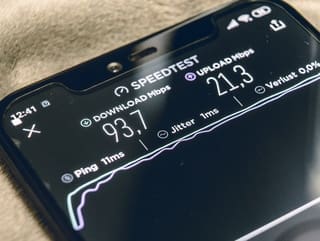Understanding Your Internet Speed Test
Mar 7, 2022 | General, Residential
Having blazing-fast internet is essential to supporting all your home’s needs, from smart-home technology to streaming movies and music. Have you wondered how fast your current internet is? Running a speed test is a great way to measure your internet performance. Here’s a simple internet speed test tool and some tips for optimizing and understanding your results.
Factors Impacting the Results of Your Internet Speed Test
Several factors can influence the results of your speed test. Before beginning, consider the following:
- For the best results, plug the computer that you will use to conduct the test directly into the router with an ethernet cable. Performing a speed test via Wi-Fi will not show the full capacity of your internet connection. Hard-wired tests yield the most accurate results.
- During the test, do not download any files or use the Internet for other activities that might use bandwidth. For accurate results, run the test without other programs running in the background.
- Different devices can yield different results. Older devices, for example, might not be able to measure the full speed of your internet connection. If one device is showing slower speeds than expected, run the test on a newer device.
- The test will automatically select the optimal server for your location. If you want to test your speeds on another server, you have the option to change it. It is important, however, to be aware that the results may vary depending on your distance from the server you’ve selected.
- Sometimes even your web browser can affect your speed test results. Don’t be afraid to run the test on both Chrome and Safari!
Now you’re ready to test your internet connection!
Understanding Your Speed Test Results
Download and Upload Speeds
Download speed shows how fast you can get information off the Internet, and upload speed shows how long it takes to get information onto the Internet. Download is important for streaming TV or downloading music, while upload is important for high-quality video chats and content sharing.
The results are displayed in Mbps, the amount of data transferred per second. Technically, this is also your bandwidth. Bandwidth is a measure of the connections your computer opens up and how much data you can download or upload. Because higher bandwidth can improve speed, these two metrics are closely connected.
Think of your internet like downtown traffic. The roads all have a speed limit, usually 35 miles per hour. If every car took the same road downtown, it would take longer to get to the city center. If the cars, however, had the option to take several different routes into town, they would arrive faster. The speed limit would remain the same, but there would be less congestion. More routes would allow more cars to arrive sooner.
Higher bandwidth essentially means more routes for your data to arrive at its destination, which means fewer network bottlenecks and faster download and upload times.
Ping
Ping measures latency, the time it takes for your device to connect and send or receive data. This is crucial for internet activities executed in real time.
Low latency is especially important to online gamers and businesses requiring real-time processing. Lower ping numbers mean better network performance and faster connections. A ping time of more than a few milliseconds can create a gaming disadvantage or can cause information delays for businesses.
Jitter
Jitter is the consistency of latency (ping) on the network. This metric measures the variation in ping times. Lower numbers are better, indicating a consistent network connection. Jitter is an important factor in overall the reliability of your internet service.
How an Internet Speed Test Works
An internet speed test mimics your internet activity and measures the speed and quality of your connection between your device and a server.
After your computer sends a “ping” or a request to the server, it begins requesting data. Using Transmission Control Protocol (TCP), the test measures your connection with the same method used to share your files and send your messages. This protocol transmits information between the server and the end user in a secure, reliable way.
To measure download speeds, the device creates several connections to the server and requests a data transmission. The device then maximizes network usage by calculating the initial transfer time, adjusting the size of the data requested, and opening more connections.
Once the optimal amount of connections has been established, the device downloads more data and calculates the time it takes to transmit the information. The computer then runs the same test but in reverse to determine the upload speeds.
We’ve Got the Speed You Need
How much speed do you need? In 2023, the average home in the United States had 17 devices connected to the internet. These devices include personal computers, laptops, tablets, smartphones, thermostats, lighting systems, security systems, smart TVs or streaming devices, gaming systems, and more. If you count the number of devices in your home that connect in some way to your home internet network, you may be surprised how quickly they add up!
Our teams at Hunter have made it simple for you to see how much speed you need based on how you and your family use the internet. Take our 30-second quiz to determine what’s best for your home.
Are you ready to switch to Hunter Communications for fast and reliable fiber internet for your home or business? Check to see if we’re in your neighborhood! It’s easy to join our fiberhood.

